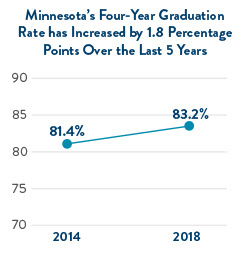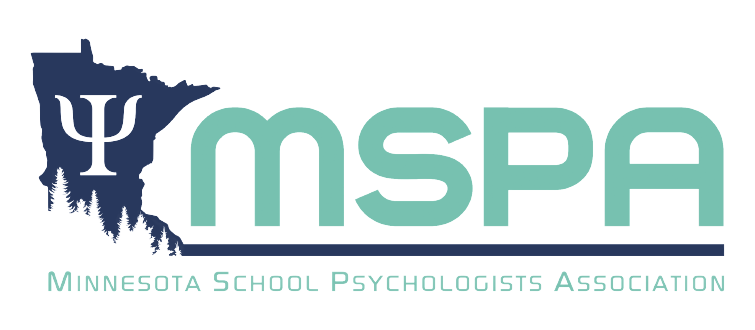Minnesota’s Graduation Rates Continue to Rise
Rates up for all student groups; gaps between student groups reduced but remain
ROSEVILLE, MN - More Minnesota seniors than ever before graduated in 2018, with 55,869 students—83.2 percent of the graduating class overall, the state’s highest graduation rate on record—achieving the honor and moving on to career and college. Additionally, 3,641 students from earlier classes also earned their diplomas in 2018, graduating five, six, or seven years after beginning high school.

“Graduating high school is a critical step on every student’s path to find their own success,” said Education Commissioner Mary Cathryn Ricker. “In Minnesota, we do not give up on our students. Behind every single data point in this year’s historic graduation rate, I not only see the unique stories of individual students, but also the hard work that educators, administrators, coaches and families put into supporting the needs of our students so they could reach this important milestone.”
Graduation rates increased statewide for all racial/ethnic student groups this year, as well as for English learners, students receiving special education services, and students qualifying for free or reduced-price meals. Over the past five years, black students—who increased 7.2 percentage points—saw the largest increase.
|
During this same period:
- American Indian/Alaska Native students increased by 2.8 percentage points.
- Asian students increased by 4.2 percentage points.
- Hispanic students increased by 3.6 percentage points.
- Students identifying as two or more races increased by 3 percentage points.
- Students receiving special education services increased by 4 percentage points.
- English learners increased by 2.5 percentage points.
- Students eligible for free or reduced-price meals increased by 3.5 percentage points.
Since 2014, graduation rates for white students have increased by 1.9 percentage points. When looking at students of color and American Indian students together, we find they have increased by 4.9 percentage points during that same time. This change represents an almost 15 percent reduction in the gap between white and nonwhite students. Putting the growth in student terms, 977 more students of color and American Indian students, including 515 more black students, graduated with the Class of 2018 than if graduation rates had stayed at 2014 levels.
“I am proud that the graduation gap is closing, but I am not satisfied,” said Commissioner Ricker. “As we move forward, I am eager to partner with communities across our state to better support all of our students.”
Eliminating disparities that are predictable based on race, ethnicity and income level has been one of the state’s highest educational priorities. Schools across the state are employing numerous approaches to support their students to reach graduation, increase the value of reaching the milestone, and building a pathway to career and college.
Districts across the state have developed innovative learning environments focused on ensuring all students have access to career and college-ready opportunities. Some of the noteworthy programs include:
- Minnesota bilingual and multilingual seals and certificates of world language proficiency are awards given to graduating seniors by districts in recognition of students who, in grades 10, 11 or 12, have demonstrated required language levels in a language in addition to English. In 2018, more than 1,600 Minnesota graduates received bilingual or multilingual seals in 14 languages: Arabic, American Sign Language, Chinese, French, German, Hmong, Japanese, Karen, Portuguese, Russian, Somali, Spanish, Tamil and Thai. This year, students are also testing in Vietnamese and Oromo, and development of Ojibwe, Dakota/Lakota, Lao and Cambodian is underway.
- Postsecondary Enrollment Options (PSEO) and Concurrent Enrollment both give high school students the opportunity to take college courses to earn high school and college credits simultaneously. In 2018, 7,164 Minnesota public school students participated in PSEO, including 1,934 students of color or American Indian students. More than 32,000 students participated in concurrent enrollment.
- State-approved alternative programs (SAAPs) provide opportunities for students who have experienced or are experiencing difficulty in the traditional education system. Approximately 52,000 students in grades 8-12 are currently enrolled in SAAPs.
- Early/Middle College Programs are unique partnerships between state-approved alternative programs and postsecondary institutions offering structured academic and nonacademic supports for students to be successful. Thirty-three districts partnered with 16 postsecondary institutions in 2018, serving approximately 350 students across the state.
- Advanced Placement (AP) provides more than 35 college-level courses and exams to high school students. Participating colleges grant credit or appropriate placement to students who scored a 3, 4 or 5 on the AP exam. In 2018, more than 60 percent of Minnesota students taking an AP course scored a 3, 4 or 5 on the AP exam.
- International Baccalaureate (IB) programs offer four highly respected programs of international education that span the primary, middle and secondary school years. Twenty-seven districts, charters and private schools have IB programs in place.
- Online schools provide students the opportunity to make up credits for graduation or engage in learning on a different platform than the traditional school to better meet their needs. Approximately 19,000 Minnesota students participate in online learning schools.
“Educators know that each student learns differently, which is why I am so encouraged to see the growth in creative programming,” said Ricker. “It is this type of innovation, including awarding students a seal of biliteracy for their language abilities, that will help students stay in school and receive their diploma.”
Accountability and Supports for Struggling High Schools
The U.S. Department of Education approved Minnesota’s state plan under the Every Student Succeeds Act in January 2018. In the plan, Minnesota set an ambitious goal that by 2020, 90 percent of Minnesota students will graduate in four years, and no single student group’s graduation rate will be below 85 percent. This goal reflects the state’s strong commitment to equity and ensuring every Minnesota student receives a high school diploma, and is bolstered by the state’s plan to identify for support any public high school with a four-year graduation rate below 67 percent overall, or for any student group.
“We recognize that the goal we set for 2020 was ambitious, and it must be,” said Commissioner Ricker. “One Minnesota includes a commitment to support all our students to graduate.”
Minnesota Department of Education Sharing #MNGraduates Stories
All day Tuesday, April 23, the department will be celebrating Minnesota graduates on social media with the hashtag #MNGraduates, highlighting their stories of accomplishment and the many ways in which Minnesota schools support and never give up on students. We have encouraged schools to join in by sharing positive stories, and we hope news media will also be a part of sharing with Minnesotans the great things going on in their schools, and the accomplishments of these young people as they move on to the next stage of their lives.
More About the Data
Graduation data are available on the Minnesota Report Card, presented in an easy-to-read, mobile-friendly layout that includes charts and graphs illustrating trends and results for all student groups.
View the complete statewide, district, school and county graduation rates in an Excel spreadsheet by visiting our Data Reports and Analytics page. Under category, choose "Graduation Rate" to access graduation indicator files for each year.
View data on enrollment in developmental education in Minnesota colleges and universities on the Minnesota Statewide Longitudinal Education Data System (SLEDS).
